The iPhone 6 Review
by Joshua Ho, Brandon Chester, Chris Heinonen & Ryan Smith on September 30, 2014 8:01 AM EST- Posted in
- Smartphones
- Apple
- Mobile
- iPhone 6
Display
As the primary mode of interaction with the phone, the display is one of the most important areas of evaluation. Of course, the methods of evaluation can be hotly debated. There is a great deal of subjectivity in this area in terms of what someone prefers. However, for the sake of color calibration our tests follow world-wide standards instead of personal preference one way or another. This means that we use the sRGB gamut and 2.2 gamma, which most content is adapted to. While AdobeRGB and other gamuts exist, these are for limited use cases and only applicable to operating systems that are aware of multiple gamuts and can dynamically switch between them depending upon the metadata of the content. In order to accurately test for how well a display conforms to these standards, we use SpectraCal’s CalMAN 5 along with a spectrophotometer for accurate color readings.
For those that are unfamiliar with the display of the iPhone 6 and Apple’s key marketing points on this new model, the improvements are mostly centered on higher resolution, contrast, and better viewing angles. In terms of higher resolution the iPhone 6 moves from the 1136x640 pixels of the iPhone 5/5s generation to 1334x750 pixels. However, this doesn’t improve the pixel density, which remains at 326 pixels per inch.
In practice, I definitely continue to notice the difference in resolution when using the iPhone 6 as opposed to the higher pixel density iPhone 6 Plus and the various Android smartphones with 450+ PPI displays. I definitely don’t find the resolution to be a problem though, as these issues only become significant to me below 300 PPI. I do think that around 450 to 500 PPI is the right place to be when balancing pixel density and power, but Apple’s choice should pay off in the form of better power consumption especially because LED backlights rapidly lose efficiency near the highest current region.
The other issue at hand is that of viewing angles. While Apple is one of the first to really talk about dual domain pixels, this technique is rather commonly used to improve viewing angles. The result is that a pair of pixels will appear to be a chevron, and overall the pixels appear to be squiggly in nature. While this doesn’t really change the readability of the display at extreme angles, colors like white no longer have noticeable red/yellow/blue shifts depending upon the angle that the display is shifted at.
This is definitely noticeable in everyday use, as the iPhone 5s could only avoid color shifting at certain angles instead of every angle. As I predicted in the launch article though, the one caveat seems to be that black has a noticeable shift towards purple in certain angles. There's also a noticeable hatching on close examination, but this doesn't affect image quality. This is definitely better than what I see on AMOLED though, as while AMOLED has much better brightness stability the color shifting is far more obvious and significant.

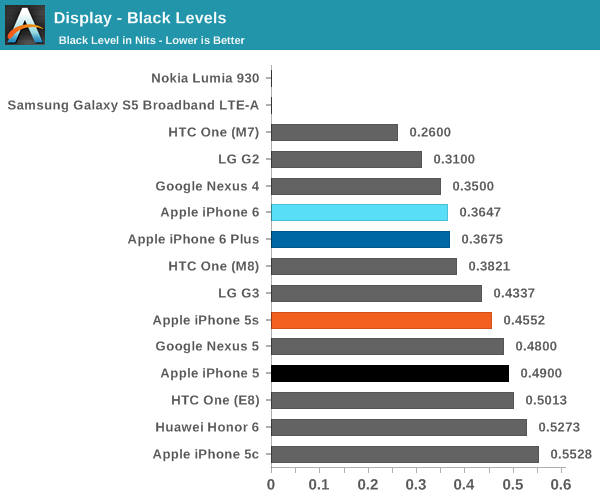

Now that we’ve covered the other two, we can talk about contrast. For this test, we measure brightness of 100% white and black at maximum display brightness, and look at the ratio. While we’re looking into getting patterns that can’t be defeated by dynamic contrast/backlight this should give an idea of best case contrast. In this case, peak brightness is on the high side at 560 nits, with relatively low black brightness at about a third of a nit. The result is one of the best contrast ratios I’ve ever seen. While the HTC One (M7) has a 1743:1 contrast ratio in our tests, some testing I’ve done indicates that the true contrast ratio is realistically around that of the One (M8). I’m not quite sure how this was done, but Apple stated that a new deposition process was used for the liquid crystals. This, along with changes to the liquid crystals themselves, could be responsible for the improved contrast.
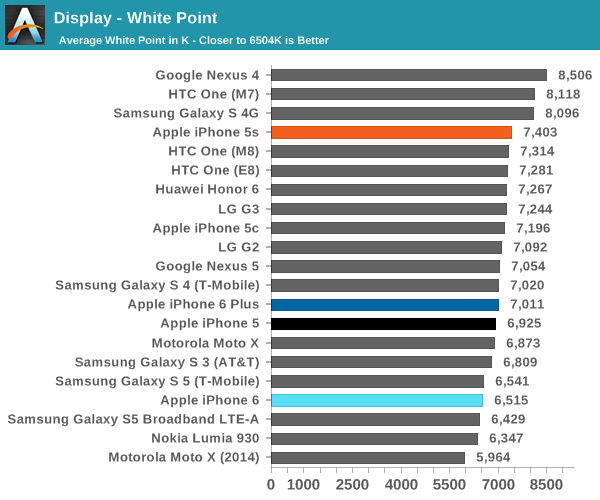
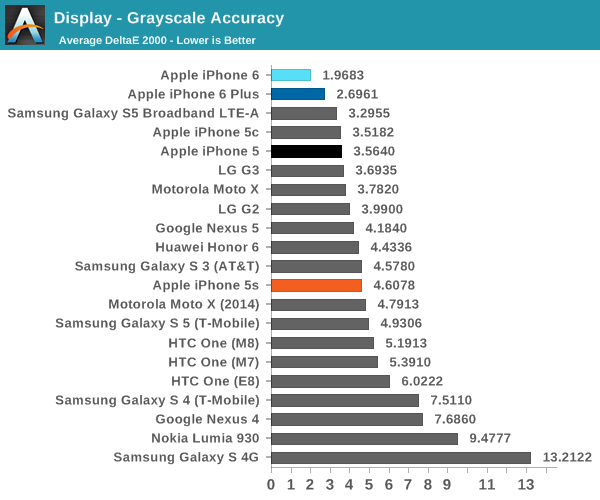
The next part to talk about is grayscale, which is an area where Apple seemed to prefer bluer color balances. I don’t really have much to pick at here, because the level of calibration here is incredible. While there is a noticeable trend of overshooting red at the low end and undershooting red at the high end, this is nitpicking at best. At any rate, this is essentially perfect.
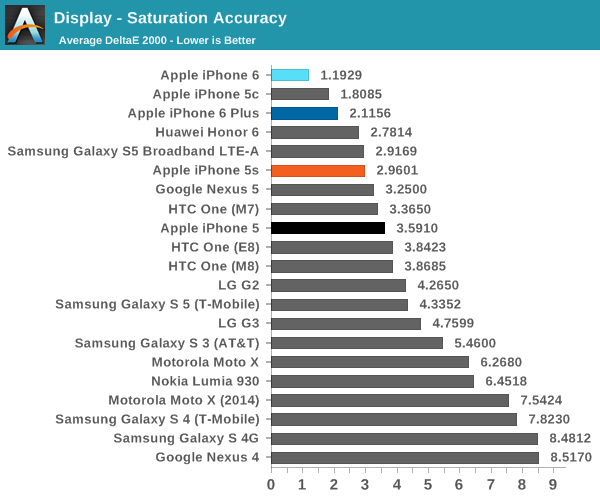
Our next test is the saturation sweep, which tests each primary and secondary color for accuracy in hue and luminance. While it’s true that humans can be relatively insensitive to differences in saturation, it is all too common to see OEMs artificially compress saturations to have vivid colors and be able to claim that they have an accurate display because it matches the sRGB gamut. In this test, the iPhone 6 sets a new record. I really don’t have any objections here because a dE2000 value of 1.19 is a deviation that is almost impossible to notice.
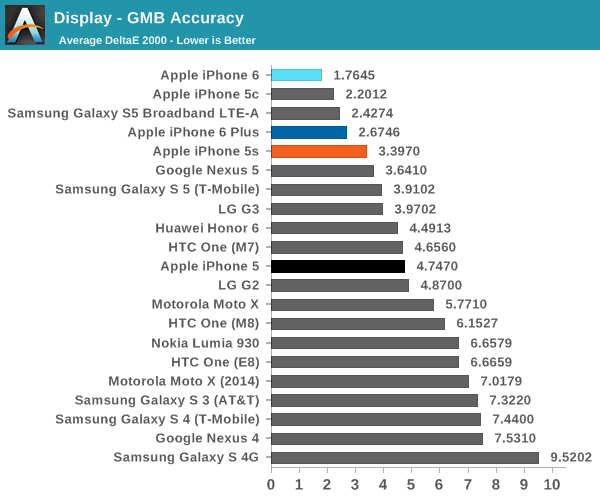
The final test is the Gretag MacBeth ColorChecker, which tests various hues and is usually one of the hardest tests to perform well in. In this regard, the iPhone 6 once again sets a new record for accuracy. This display is effectively calibrated to sRGB, and one would be hard pressed to find a significant deviation when compared to a reference monitor.
Overall, it’s hard to find any criticism for this display. I would normally be incredibly suspicious to see these numbers on a smartphone, but the fact that there’s a hot pixel in the center of the display suggests to me that this was not a cherry-picked unit. The fact that I find this level of calibration to be suspicious speaks volumes about how good this display is. While contrast isn't AMOLED levels of black, there are no purple smearing effects, noticeable uneven luminance near black, or any other idiosyncrasies.


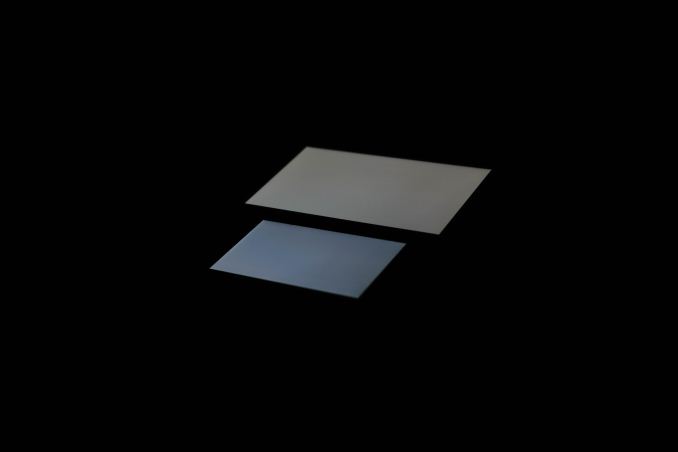
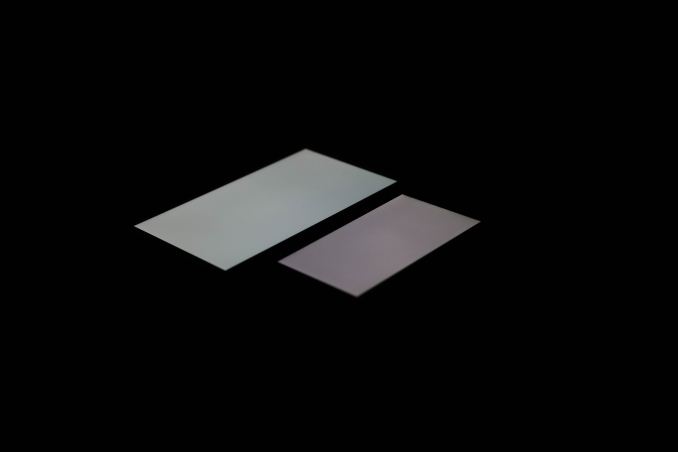
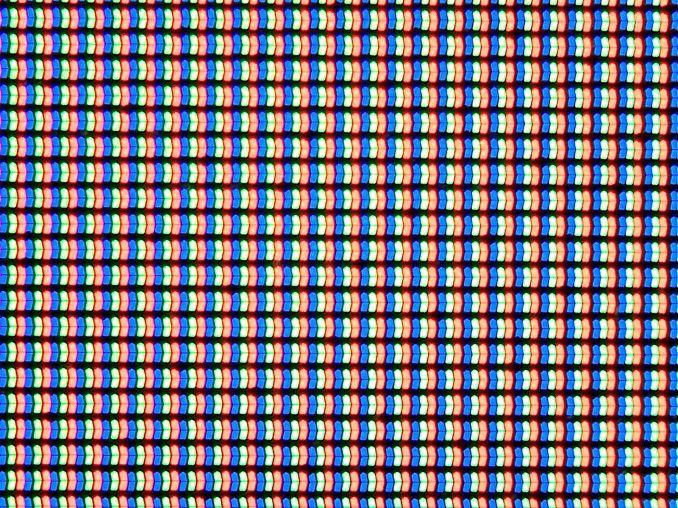

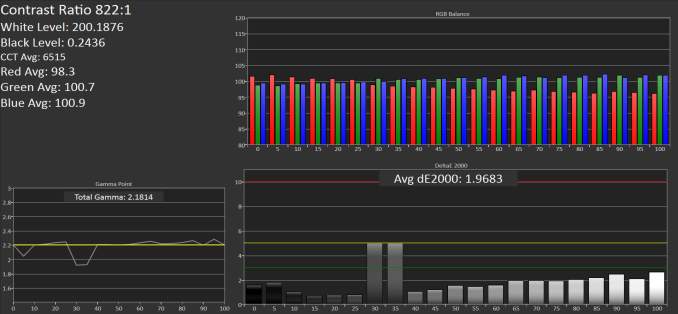

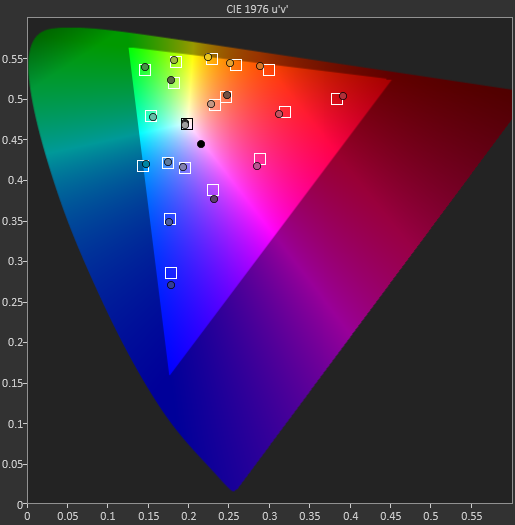








531 Comments
View All Comments
Torakaru - Thursday, October 2, 2014 - link
Which Galaxy did you used? Because I have been reading around that 1GB is not enough and many users complaint about it (doesnt matter if iPhone5/5s/6/6+ or last year iPad's) as for instance the Safary crashes/fully reloads even after more than a couple of tabs in use.Ryan Smith - Thursday, October 2, 2014 - link
"Could you be so kind to be more precise about that feeling that you have? It is due lack of RAM for multitasking, or also for single tasks?"It's a lack of RAM for multitasking. At some point the OS will reach its limit and be forced to evict apps and/or cached Safari tabs. The 5S and 6 have a it a bit worse than the 5 due to the fact that the AArch64 processors in the 5S and 6 require additional RAM to be allocated to the OS to operate the 32bit and 64bit user lands simultaniously.
refineryorker - Wednesday, October 1, 2014 - link
The other interesting thing I noticed about this review and many of the top performing non I phones is that for American consumers, a lot of these phones don't really exist to purchase on the major U.S. carriers.I visited the t mobile, sprint, Att, and Verizon websites and
The Hauwei honor 6, the Samsung Galaxy s5 broadband lte a, Nokia lumia 930, Nokia lumia 630, and the Xperia z1s don't exist on those websites.
The Samsung Galaxy s5 T-Mobile only exists for T-Mobile.
The HTC one e8 is only on sprint.
So all this means is that the List of phones that Americans can purchase looks vastly different than the top performing non iPhones on the above list.
Most non iPhones that Americans can purchase aren't top performers.
roncron - Wednesday, October 1, 2014 - link
I've read at least 15 reviews of the iPhone 6, including the excellent review at iLounge.com. But this review is the best of them all. Very thorough and scientific. The review, while long, is also well-written and nicely organized.Ryan Smith - Thursday, October 2, 2014 - link
Thank you.cknobman - Wednesday, October 1, 2014 - link
I take your battery test results with a grain of salt when it comes to actual real world use. I know they are scientific but it just seems they paint the iPhones as having great battery life when in reality it blows.We have two iPhone 5s in our house, an LG G2, a Nokia Lumia 1520, and a SG4.
In practical use the iPhone's cant even get through 3/4 of a day without being drained dry.
The SG4 can barely make it to evening.
The LG G2 can make an entire day easy but needs to be recharged every day.
The Nokia can go 2 days without being charged.
Before getting the iPhone 5s's I read reviews thinking that those things should get better battery life than the SG4, most of that opinion coming from reviews like yours. Little did I know that those thoughts were bogus.
I dont expect much more practical battery life from and iPhone 6 either. This is not isolated to my house either.
munim - Wednesday, October 1, 2014 - link
It doesn't seem like you're trolling so think about the following factors:I'm assuming different people are using each phone. They probably have different usage habits, different apps syncing, different amount of apps syncing, maybe one person uses the phone more outdoors using higher brightness / GPS / LTE as opposed to wifi.
zhenya00 - Wednesday, October 1, 2014 - link
Without some context your comparisons are useless. I presume the phones are owned by different family members and see different usage patterns. Perhaps some of them are backup or work/non-primary phones. Perhaps the iPhones used more heavily than the others as is often the case (I have family members who own iPhones and have work provided Blackberries - I bet they'd say the iPhone has poor battery life as all but which one are they using all day and which one sits on the counter?)You could have bad backups you've restored to them that cause drains, or other problem software. My 5s tended to see about 2.5 hours of 'use' per day, and I'd tend to get about 5 usage hours and 2 days between charges. The 6 seems to be giving me closer to 7-8 hours of use, and again, 2 days of standby.
cknobman - Wednesday, October 1, 2014 - link
I cannot give you exact usage patterns for all of the phones.BUT
The iPhone 5s's and the LG G2 are used by my 3 teenagers (two 16, one 14). They all do plenty of facebooking, instagraming, messaging, and tweeting. While non of them have the exact same usage pattern I can safely say that they are all similar. I find it ironic that the two iPhones just happen to be unable to get through a 8 hour period without losing charge. I had to buy both of those phones battery cases for my kids. The LG G2 on the other hand has never had a battery problem.
As for the SG4, that is used by my wife who is a facebook, instagram, and pintrest junky. She can drain a battery on anything in a day. Usually her phone makes it from morning until night but sometimes she kills it before bedtime.
The Nokia is mine and it gets a decent amount of use. During the day not a lot of things going on it while I am at work outside of games when Im in the restroom and during lunch. Once at home it is my primary source of access to anything digital I need. I dont touch a computer once I leave the office.
beggerking@yahoo.com - Wednesday, October 1, 2014 - link
I have the same conclusion with mine. Nokia seem to last forever on tiny batteries.